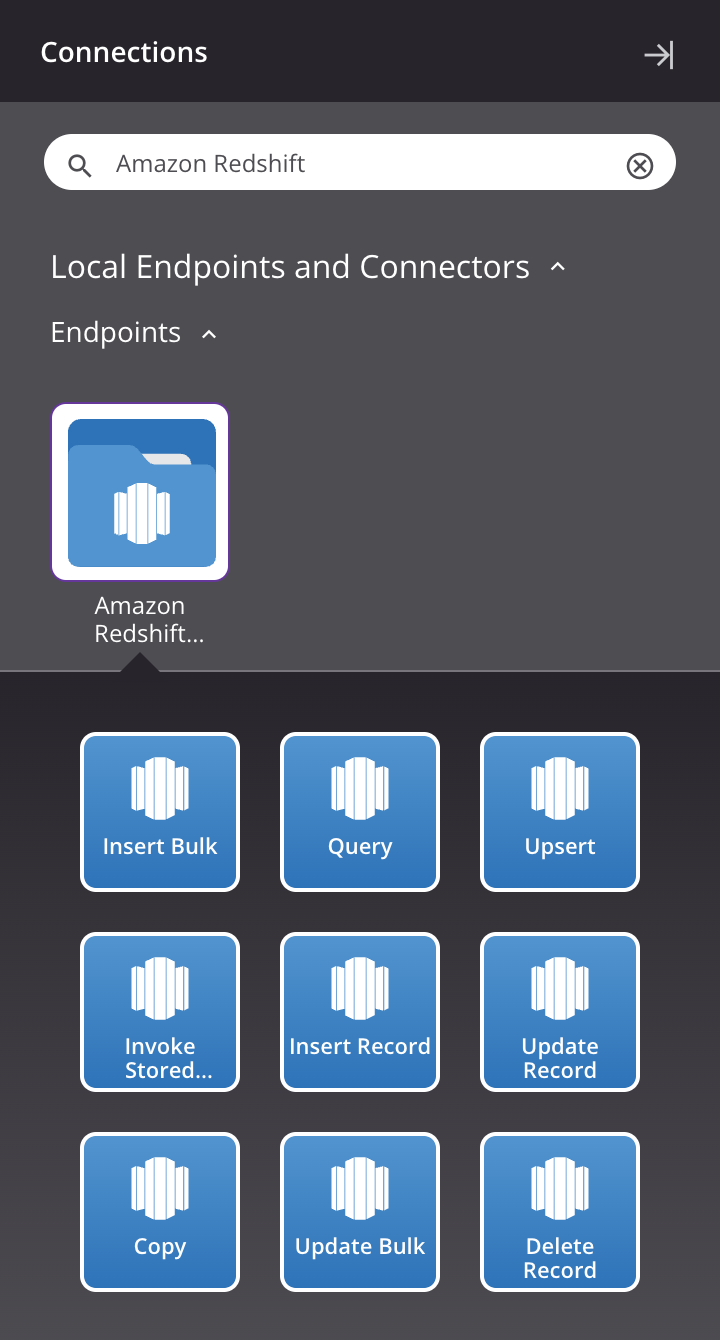Amazon Redshift connector for Jitterbit Integration Studio
Summary
The Amazon Redshift connector establishes access to Amazon Redshift.
The Amazon Redshift connector provides an interface for creating an Amazon Redshift connection, the foundation used for generating instances of Amazon Redshift activities. These activities, once configured, interact with Amazon Redshift through the connection.
The Amazon Redshift connector is accessed from the design component palette's Project endpoints and connectors tab (see Design component palette).
Connector overview
This connector is used to first configure an Amazon Redshift connection. Activity types associated with that connection are then used to create instances of activities that are intended to be used as sources (to provide data in an operation) or targets (to consume data in an operation).
Together, a specific Amazon Redshift connection and its activities are referred to as an Amazon Redshift endpoint:

-
Insert Bulk: Inserts multiple records into a table at Amazon Redshift and is intended to be used as a target in an operation. This activity provides the option to set the number of records per batch and the option to stop processing the remaining records if an error is found.
-
Query: Retrieves records from a table at Amazon Redshift and is intended to be used as a source in an operation.
-
Upsert: Updates an existing object or creates a new object in Amazon Redshift and is intended to be used as a target in an operation.
-
Invoke Stored Procedure: Calls a stored procedure from within a schema at Amazon Redshift and is intended to be used as a target in an operation.
-
Insert Record: Inserts a record into a table at Amazon Redshift and is intended to be used as a target in an operation.
-
Update Record: Updates a record in a table at Amazon Redshift and is intended to be used as a target in an operation.
-
Copy: Inserts records into a table at Amazon Redshift, and is intended to be used as a target to consume data in an operation.
-
Update Bulk: Updates multiple records in a table at Amazon Redshift and is intended to be used as a target in an operation. This activity provides the option to set the number of records per batch and the option to stop processing the remaining records if an error is found.
-
Delete Record: Deletes a record from Amazon Redshift and is intended to be used as a target in an operation.
Note
This connector is a Connector SDK-based connector, which may be referred to by Jitterbit when communicating changes made to connectors built with the Connector SDK.
Prerequisites and supported API versions
The Amazon Redshift connector requires the use of an agent version 10.1 or later. These agent versions automatically download the latest version of the connector when required.
The Amazon Redshift connector uses the Amazon Redshift JDBC Driver version 2.1.0.28 and Amazon Redshift SQL Commands. Refer to the Amazon Redshift documentation and the Amazon Redshift System Overview documentation for additional information.
Troubleshooting
If you experience issues with the Amazon Redshift connector, these troubleshooting steps are recommended:
-
Click the Test button in the connection configuration to ensure the connection is successful and to ensure the latest version of the connector is downloaded to the agent (unless using the Disable Auto Connector Update organization policy).
-
Check the operation logs for any information written during execution of the operation.
-
Enable operation debug logging (for cloud agents or for private agents) to generate additional log files and data.
-
If using private agents, you can enable connector verbose logging for this connector using this specific configuration entry of logger name and level:
<logger name="org.jitterbit.connector.amazon.redshift" level="DEBUG"/> -
If using private agents, you can check the agent logs for more information.
-
For additional troubleshooting considerations, see Operation troubleshooting.